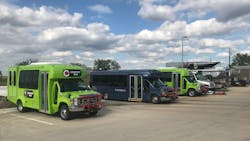NCRTD to enter MOU with CTAA to create roadmap for developing AVs
The North Central Regional Transit District (NCRTD) will enter a Memorandum of Understanding (MOU) with the Community Transportation Association of America (CTAA) to evaluate and create a roadmap for the potential development of autonomous vehicle (AV) technology for public transportation systems in north central New Mexico.
CTAA’s National Center for Applied Transit Technology (N-CATT) would implement the cooperative study in partnership with the NCRTD, the Santa Fe Trails transit system and Atomic City Transit in Los Alamos, N.M. The significant step marks the first study of its kind in New Mexico to explore innovative AV solutions for public transportation.
NCRTD, along with Atomic City Transit and Santa Fe Trails, aims to research and better understand the benefits, implications, risks and strategies involved in utilizing AV technology to address public transportation challenges. As the national bus operator shortages persists, the agencies seek to explore pilot service options to ensure communities do not suffer from a lack of mobility options.
"By partnering with N-CATT and CTAA, we are taking a proactive approach to address the evolving landscape of public transportation," said Anthony Mortillaro, NCRTD executive director. "This collaboration will enable us to evaluate and harness the potential of AV technology to enhance transit services and meet the needs of our communities."
The MOU includes providing access to data, collaborating on research efforts and implementing recommendations to ensure the successful evaluation of AV technology.
"We are excited to collaborate with NCRTD on this important initiative," said Scott Bogren, executive director of CTAA. "Through our partnership, we aim to leverage the expertise of N-CATT to support NCRTD's efforts in exploring autonomous vehicle technology and its potential impact on public transportation."
The project is expected to be completed by June 30, 2025, with the possibility of extension by mutual agreement.
